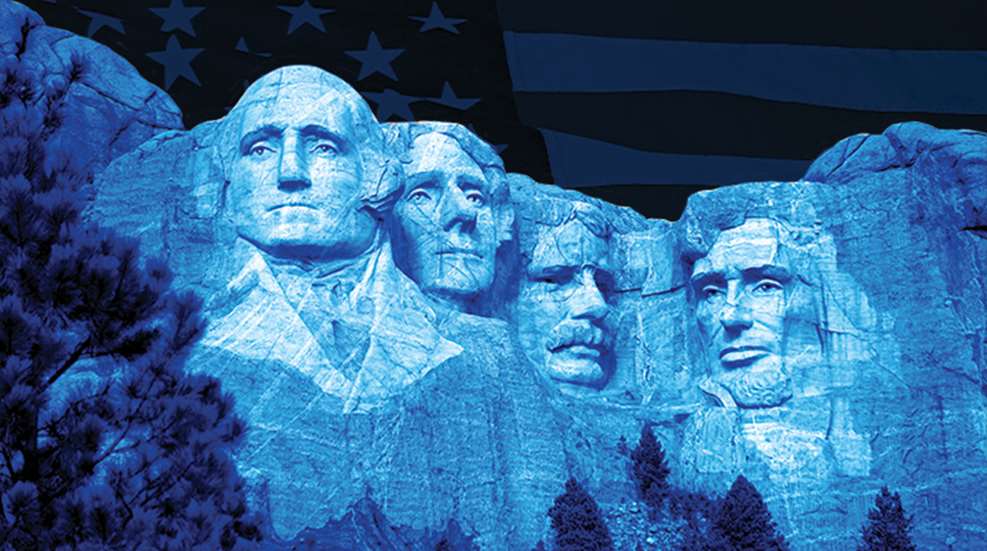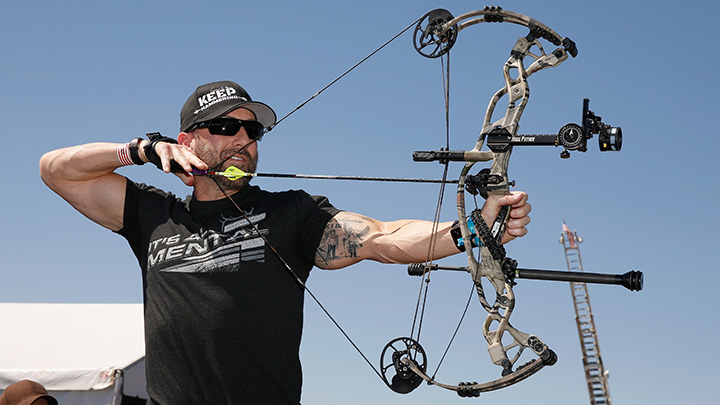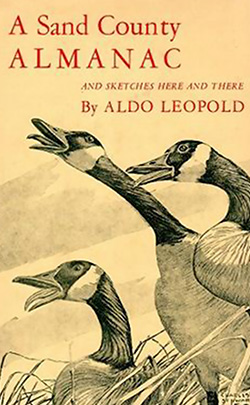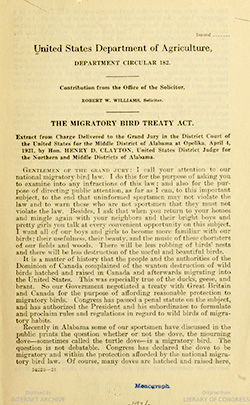
When I think about the future of hunting, I consider Cameron Hanes. You might think that strange, and if you don’t, you should. Hanes is a bowhunting junkie whose “Lift Run Shoot” lifestyle, as he summarizes it, has attracted a massive social media following. He crushes a couple of marathon-length runs a week. His mottos, “Keep Hammering” and “Nobody Cares, Work Harder,” appear on T-shirts gobbled up by his fans, who are mostly young men. His very manly persona has drawn many of these young men into bowhunting and all the self-improvement that comes from struggling to be a successful predator.
The point is, if a person can become all that Hanes has in today’s surreal, social media, alternate-reality world while attracting legions of fans from Instagram—he has more than 800,000 followers there alone—then there is little doubt there is a future for hunting in America. It just might not be what we think it is.

Hunters might become, dare I say it, hip. Nothing, after all, is more “green” than game meat naturally harvested from the wild. Nothing is more environmentally friendly than hunters managing game populations as they pay fees and taxes that fund conservation projects all over America. Imagine that, a few years after Cecil the lion and all the lies the mainstream media spun about that hunt-turned-public-relations nightmare (for anyone who earns their own meat), hunting could actually bust into the realm of popular culture and be what it hasn’t been since at least the 1950s—it could be cool!
Right now, the trend Hanes is a part of is more counterculture or subculture than mainstream, as the hunter's role in the natural cycle of things still isn’t popularly understood today. But the signs of change are here. The meteoric rise of the “Duck Commander,” which morphed into the popular A&E show “Duck Dynasty” a few years back, did reach the mainstream. Steven Rinella’s show on Netflix is also reaching non-hunters. So is the actor Chris Pratt, who announced a while back that he’d only eat meat he killed for an entire year (he did immediately carve out exceptions, like maybe a basket of spicy hot chicken wings now and then). Also, popular reality TV shows on the Discovery Channel and other networks, such as “Alaska: The Last Frontier,” often show people hunting to secure meat before the north’s long winters settle in. Even the Discovery Channel’s “Naked and Afraid” often shows its nude participants doing all they can to kill their own meat.
Obviously, hunting isn’t necessarily anything more than a dying pastime made up of a fading 5 percent of Americans. A movement for grass-fed beef, free-range poultry and hormone-free meat has made many see game meat in a new way. Meanwhile, outdoor adventure is a growing lifestyle for many looking for escapes from urban life.
This keeps me thinking of Cameron Hanes, as he is a social media influencer who is entirely organic. Hanes isn’t doing something non-hunters can write off as an understandable exception as they can for people living a subsistence life in the Alaska bush. Hanes, like the rest of us, hunts because he is drawn to it. He also isn’t a real-life Katniss Everdeen in The Hunger Games sneaking away to kill game to feed a starving family. He is hunting because it’s in his blood. He hunts because he understands his real role in the natural world. We are omnivores, and even if we deny we have canine teeth by becoming vegetarians, the farmers who raise the crops we eat still have to protect them from deer, geese and more, so either way there is blood on all of our hands. That’s as it should be. That’s natural. That’s honest.
People are actually following Hanes because he is the real deal. His authenticity even grabbed the attention of the comedian, actor and UFC announcer Joe Rogan. Rogan invited Hanes onto his podcast, a podcast 1 million people have watched on YouTube. “He just struck me as this odd human being,” Rogan said. “He’s a very stoic kind of quiet but intense guy, and he’s absolutely obsessed with perfection and perfection in bowhunting and the moment of the kill, like being at his physical best to be able to perform the perfect shot, and kill an animal in perfect ethical fashion.”
Rogan is also a bowhunter. He talks about it sometimes. He has mule deer racks in the background of some of his podcasts, which by the way get millions of views on YouTube and, he says, more than 100 million downloads a month. Surely the fact that a guy like Rogan can be a hunter and not be bashful about it signals a change in the media landscape or at least an opportunity.
Hanes, as you might expect, has endured what any hunter who becomes popular on social media does. He has been attacked and threatened. He was the focus of an unsuccessful Change.org petition demanding that Under Armour, one of his sponsors, stop paying him. They didn’t.
Hanes has often defended his hunts in posts on Facebook and Instagram. Under a picture with a black bear he killed, he wrote: “Some will look at this photo and see a dead bear and a smiling hunter and get mad. Mostly because they don’t understand or don’t want to. These same people eat steak but don’t see a dead cow because they’ve detached themselves from the circle-of-life. Fact is, there are different levels to it but life eats life, and no one can argue that. When I look at this photo I see an amazing experience captured in one image. An animal I respect, honored in a vivid memory.”
Hanes is a cultural warrior, though he doesn’t wear it on his sleeve. He gives the impression he’d rather not have to explain; he’d rather just show. Some hate him for this. Many respect him for it. Hunters can learn a lot from his honest, respectful but open approach.
“Man has always been part of the equation as we’ve always hunted,” Hanes also wrote. “And, we must continue to be. Hunting is conservation.”
Hanes, in his words but more importantly in his actions, is showing us we need to positively step forward. In contrast, hunters, hunting-related companies and hunting-conservation groups are often too conservative. They’re afraid to offend. None of us want to attract negative attention. We’d understandably prefer to enjoy our pastimes without worrying about culture wars. We go to the woods to get away from all that. But we can’t hide in the woods and expect our sports to continue.
All of this has now led hunters to a new moment for hunting in America. We can either revitalize the hunter-conservation movement by proudly and loudly finding ways to make what hunter-conservationists do clear to the general public or we can allow hunting to be increasingly misunderstood and marginalized on social media and by the mainstream media.
A good way to push back is for us to articulate what we’re for to the 94 percent of the American public that doesn’t hunt. Here’s a start. Here are seven principles for us to boldly stand on. As you read them, realize that American Hunter wants to hear from you. What else can hunters do? Are there other principles you think should be included? Would you like to edit these? Let us know and we’ll publish your responses later as a part of this important and continuing conversation.
Principle 1: People Are a Part of The Wild
As any honest wildlife biologist can tell you, we are not separate from the natural world. Wildlife doesn’t respect the invisible boundaries around our public lands. Unless we want to fence-off nature, we have to concede we share ecosystems with wildlife. This then requires us to balance our needs with wildlife. Hunting is an important part of keeping this balance across America—and with keeping our wild roots.
Principle 2: Wildlife Belongs to All of Us
This is foundational to the North American Model of Wildlife Conservation. Since the 19th century, many U.S. courts have upheld and refined the premise that fish and wildlife belong to all. Still, any landowner who owns a lot of land can effectively control how wildlife is locally managed. This is why the NRA and many hunter-conservation groups support Walk-In Access programs and other ways for allowing average Americans to help control and conserve our wildlife.

Principle 3: Hunters Are Game Managers
Aldo Leopold, the father of modern wildlife management, began his eloquent crusade for a science-based system of conservation in the 1920s and ‘30s. Leopold, who was a hunter, helped refine a new ethos that led to trained biologists crafting pro-hunting policies based on scientific data. This process is influenced by hunters who attend public hearings held by state game agencies on changes to seasons and more. Some environmentalists are doing all they can to short-circuit this system. We have to stay aware and prevent them from using their emotion to trump reason.
Principle 4: Hunting Has Deep Ethical Rules
In 1900, Sen. John F. Lacey helped push the Lacey Act through Congress. This act banned trafficking of wild game meat, ending the slaughter by market hunters, which gave wildlife a chance to recover. Not selling our hard-earned game meat is only one segment of an overall hunter ethic that starts with fair chase. We need to understand and teach this ethic.
Principle 5: We Can All Get Along
Everyone has the opportunity to influence conservation. Hunters and non-hunters alike have advocated for landmark environmental laws. Also, hunter-conservation groups often work together to lobby for important conservation programs as part of the Farm Bill and more. Hunters need to stand together.

Principle 6: Collaboration is Fundamental
Waterfowl migrate across boundaries between states, provinces and countries. Such is why it was critical that the Migratory Bird Treaty Act of 1918 made it illegal to kill ducks and geese except as allowed by regulated hunting. These and other protections have been critical to bringing back so many waterfowl species.
Principle 7: Introduce Others to The Hunt
Talking about hunting to non-hunters can be difficult. But we can’t shy away from this anymore. They’ll likely be surprised to hear just how much hunter-conservationists do. They also might not know that taxes on firearms and ammunition, for example, fund conservation. Likewise, they might not be aware that hunting license sales also pay for so much game and non-game animal research and protections. When they find out how central hunting is to conservation they might just want to try it themselves, if only to get a little wild, free-range meat for their table. The NRA has a lot of resources to help hunters get started, to find training courses and so much more.
7 Core Principles of the North American Model of Wildlife Conservation
The core principles of the North American Model of Wildlife Conservation were developed in the early 20th century, but have since been summarized by these seven tenets.
Wildlife is Held in the Public Trust: This means fish and wildlife are managed by the public through state and federal governments—though an individual can own land, he or she cannot own the wildlife on it. Wildlife is owned by all citizens.
Elimination of Markets for Game: Commercial hunting and the sale of wildlife is prohibited to ensure the sustainability of wildlife populations. This principle holds that unregulated economic markets for game and non-game wildlife are unacceptable because they privatize a common resource and lead to declines. The Lacey Act of 1900 effectively made market hunting illegal in the United States, and the Migratory Bird Treaty Act of 1918 provided international protections from the market.
Allocation of Wildlife by Law: Wildlife is allocated to the public by law, as opposed to market principles. Democratic processes and public input into lawmaking help ensure access is equitable.
Wildlife Should Only be Killed for a Legitimate Purpose: Under the North American Model, the killing of game must be done only for food, fur, self-defense and the protection of property (including livestock).
Wildlife is Considered an International Resource: As wildlife does not exist only within fixed political boundaries, effective management of the resource must be done internationally, through treaties and the cooperation of management agencies.
Science is the Proper Tool for Discharge of Wildlife Policy: The North American Model recognizes science as a basis for informed management and decision-making processes.
Democracy of Hunting: This tenet is inspired by Theodore Roosevelt’s idea that open access to hunting results in many benefits to society.




































